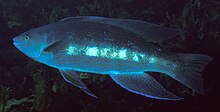This is an old revision of this page, as edited by BoyTheKingCanDance (talk | contribs) at 06:50, 11 January 2025 (added Category:Ray-finned fish using HotCat). The present address (URL) is a permanent link to this revision, which may differ significantly from the current revision.
Revision as of 06:50, 11 January 2025 by BoyTheKingCanDance (talk | contribs) (added Category:Ray-finned fish using HotCat)(diff) ← Previous revision | Latest revision (diff) | Newer revision → (diff)
| Hypsigenyini | |
|---|---|

| |
| Hogfish (Lachnolaimus maximus) | |

| |
| Greenbone (Odax pullus) | |
| Scientific classification | |
| Domain: | Eukaryota |
| Kingdom: | Animalia |
| Phylum: | Chordata |
| Class: | Actinopterygii |
| Order: | Labriformes |
| Family: | Labridae |
| Tribe: | Hypsigenyini Gomon (1997) |
| Genus | |
|
15-17., see text | |
The hypsigenyine wrasses are saltwater fish of the tribe Hypsigenyini, a subgroup of the wrasse family (Labridae). The group is circumglobal, being found in almost all the of world's shallow tropical marine waters, although some species are also found in temperate zones.
Taxonomy
Hypsigenyini is the sister group to all other wrasse tribes. The group was first proposed in 1997. Since then, molecular phylogenetics has found that it also includes odacines and the genus Pseudodax. Odacines were once considered to be their own taxonomic family, but have been found nested deep within the hypsigenyine wrasses, and are most closely related to the hypsigenyine genera Xiphochelius and Choerodon. Odacines remain a monophyletic group however. Pseudodax was once considered to be the closest relative to parrotfish (tribe Scarini), but is now considered a basal hypsigenyine. The hogfish (Lachnolaimus maximus) is the sister group to all other hypsigenyine wrasses.

Hypsigenyine wrasses exhibit several ancestral features shared with perciforms, but were subsequently lost in more derived wrasses. One such example is the presence of vomerine teeth. The Italian fossil wrasse †Phyllopharyngodon is strongly supported to be a hypsigenyine, and is about 50 million years old, dating to the Eocene.
Genera
| Genus | Image | |
|---|---|---|
| Achoerodus T. N. Gill, 1863 | ||
| Anchichoerops Barnard, 1927 | ||
| Bodianus Bloch, 1790 | ||
| Choerodon Bleeker, 1840 | ||
| Decodon Günther, 1861 | ||
| Lachnolaimus G. Cuvier, 1829 | ||
| Polylepion M. F. Gomon, 1977 | ||
| Pseudodax Bleeker, 1861 | ||
| Terelabrus J. E. Randall & Fourmanoir, 1998 | ||
| Odacine
clade |
Haletta Whitley, 1947 | |
| Heteroscarus Castelnau, 1872 | ||
| Neoodax Castelnau, 1875 | ||
| Odax Valenciennes, 1840 | ||
| Parodax Scott, 1976 | ||
| Olisthops Richardson, 1850 | ||
| Sheardichthys Whitley, 1947 | ||
| Siphonognathus Richardson, 1858 | ||
References
- ^ Westneat, Mark W.; Alfaro, Michael E. (2005-08). "Phylogenetic relationships and evolutionary history of the reef fish family Labridae". Molecular Phylogenetics and Evolution. 36 (2): 370–390. doi:10.1016/j.ympev.2005.02.001.
{{cite journal}}: Check date values in:|date=(help) - Hughes, Lily C; Nash, Chloe M; White, William T; Westneat, Mark W (2023-05-01). "Concordance and Discordance in the Phylogenomics of the Wrasses and Parrotfishes (Teleostei: Labridae)". Systematic Biology. 72 (3): 530–543. doi:10.1093/sysbio/syac072. ISSN 1063-5157.
- Clements, Kendall D; Alfaro, Michael E; Fessler, Jennifer L; Westneat, Mark W (2004-08). "Relationships of the temperate Australasian labrid fish tribe Odacini (Perciformes; Teleostei)". Molecular Phylogenetics and Evolution. 32 (2): 575–587. doi:10.1016/j.ympev.2004.02.003.
{{cite journal}}: Check date values in:|date=(help)